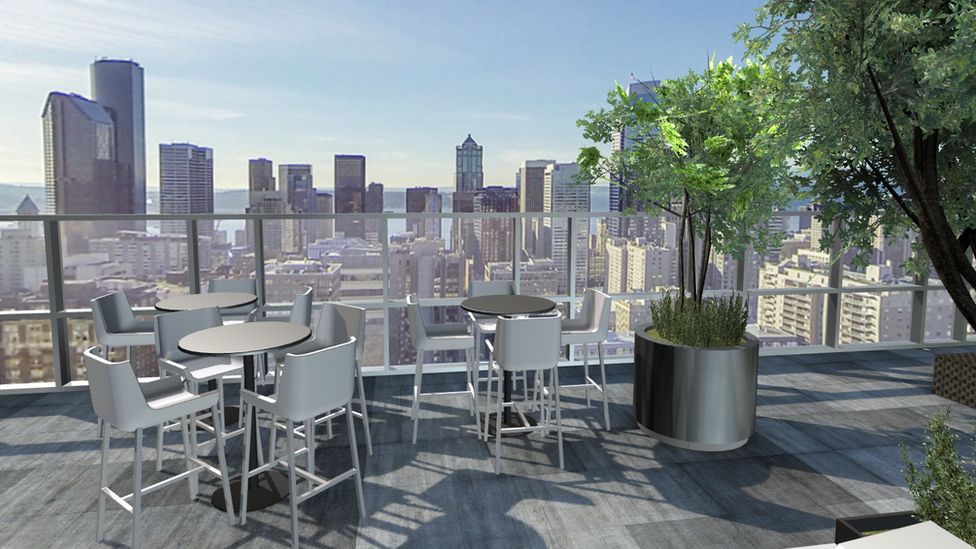How to check out your next penthouse from your armchair
- Published

Property hunting can be a grinding chore. But what if you could have a good nose round your prospective "des res" without getting up from your chair?
This is what Sotheby's International Realty is offering viewers of its luxury properties through the application of virtual reality (VR) technology.
"We see a use case where a client can come to one of our offices, come into a virtual reality station and experience the property through a VR headset," says John Passerini, global vice president for interactive marketing.
"They could be in Paris looking at a New York City property and get a real feel for what that property is like."
Sellers wanting their properties to stand out in a competitive market can no longer rely solely on high definition photos and videos, he says: "The next evolution is virtual reality."
Many Sotheby's estate agents are working with Matterport, a tech company specialising in high-definition 3D content of interiors, while some of its agents have invested in their own VR cameras.
Customers can drop by its downtown sales centre, pop on an Oculus Rift headset, and take a tour - which also means being able to see how the view changes as you move higher up the buildings.
Studio216 partner Boaz Ashkenazy says his company is also working on commercial projects using Microsoft's HoloLens - a headset that mixes the real world with the digital.
While VR is primarily used for luxury properties, both Luma and Sotheby's see VR viewings becoming the norm for all types of property.
Indeed, Goldman Sachs predicts that the VR for the real estate market will be worth $1.6bn (£1.1bn) by 2025.
That's entertainment
And real estate is just one business sector embracing a technology most closely associated with gaming. The live entertainment industry is also excited about the prospects for VR.
Ticket marketplace Rukkus is enabling live sports and music fans to check out the view from different seat positions using a platform called Seat360.
Gig goers can make sure they don't end up sitting behind a pillar in the "nosebleed seats", says chief executive Manick Bhan.
"The 360-degree views are generated using real photographs, captured by a combination of our team and some very dedicated fans using a special camera rig," he says.
It's in the process of capturing images of major baseball, football, and concert venues.
But VR could go much further, allowing viewers to experience live music concerts and even giving them better views than if they were actually there.
For example, NextVR from California wants to give virtual fans live 3D views of concerts and events from the front row or even from the stage itself. It has signed a deal with with major music promoter Live Nation to that effect.
Lively lessons
VR tech also has huge potential in the education and training sector, giving teachers the opportunity to provide much more vivid and absorbing experiences for their students.
"If you're talking about marine biology, why not hold that class on the seabed and have a whale swim through the centre of the class? It's a lot more immersive and engaging," says David Whelan, chief executive of Immersive VR Education, a tech firm specialising in this type of content.
Mr Whelan believes VR could make massive open online courses, or Moocs, much more engaging and help raise completion rates, which can be as low as 7%.
"What we're hoping to achieve with virtual reality is that [students] feel like they're talking to real people and interacting in a more natural way, and that more will adapt to finish the course in the end."
Of course, students will need to own their own VR headset to appreciate the full experience, so costs will have to fall dramatically if students in developing economies are going to benefit.
Big engineering firms, such as Boeing, are also using VR to help train their staff in engine maintenance, while auto makers like BMW are using it to test real cabin designs in virtual environments.
And retailers are exploring the opportunities for virtual showrooms and enhanced customer service.
For example, music store Dawsons lets its online customers get a good look at instruments by making sales staff put on a pair of Epson-made smart glasses.
The live video feed from the glasses is fed through to the website, so the customer sees exactly what the sales person is seeing. The online customer can then direct the video and ask questions during the demonstration.
Feeling sick
While business is undoubtedly showing interest in the potential of VR - more than $1.7bn has been invested in VR start-ups in the last 12 months, says investment adviser Digi-Capital - there are big hurdles to overcome if the tech is to take off.
One of those is the feeling of nausea headset wearers often feel. To help neutralise this effect we need more powerful graphics processing units (GPUs) capable of processing images fast enough to remove any delays, or latency, says Roy Taylor, corporate vice president at chip maker AMD.
More features about the Future of Work
"If your computer can't keep up, it makes you throw up," he says.
To achieve a live, totally realistic experience, headsets will need to be much lighter and feature two powerful GPUs - one for each eye - capable of processing images at about 144 frames per second (fps), he says.
Current headsets process images at about 90fps, so that's a huge leap in computing power required, but Mr Taylor remains confident this is achievable.
VR has its limitations - not least the cumbersome headgear - but tech optimists think these issues will be addressed in time.
Virtual business could become good business.
Follow Technology of Business editor Matthew Wall on Twitter @matthew_wall